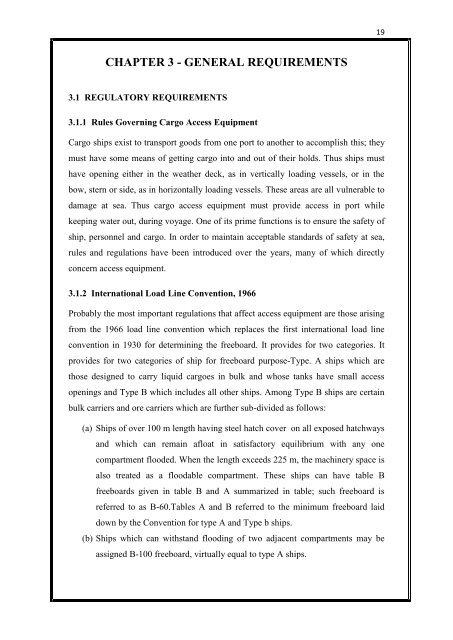Single pull macgregor type hatch cover.pdf - Cochin University of ...
Single pull macgregor type hatch cover.pdf - Cochin University of ...
Single pull macgregor type hatch cover.pdf - Cochin University of ...
Create successful ePaper yourself
Turn your PDF publications into a flip-book with our unique Google optimized e-Paper software.
CHAPTER 3 - GENERAL REQUIREMENTS<br />
3.1 REGULATORY REQUIREMENTS<br />
3.1.1 Rules Governing Cargo Access Equipment<br />
Cargo ships exist to transport goods from one port to another to accomplish this; they<br />
must have some means <strong>of</strong> getting cargo into and out <strong>of</strong> their holds. Thus ships must<br />
have opening either in the weather deck, as in vertically loading vessels, or in the<br />
bow, stern or side, as in horizontally loading vessels. These areas are all vulnerable to<br />
damage at sea. Thus cargo access equipment must provide access in port while<br />
keeping water out, during voyage. One <strong>of</strong> its prime functions is to ensure the safety <strong>of</strong><br />
ship, personnel and cargo. In order to maintain acceptable standards <strong>of</strong> safety at sea,<br />
rules and regulations have been introduced over the years, many <strong>of</strong> which directly<br />
concern access equipment.<br />
3.1.2 International Load Line Convention, 1966<br />
Probably the most important regulations that affect access equipment are those arising<br />
from the 1966 load line convention which replaces the first international load line<br />
convention in 1930 for determining the freeboard. It provides for two categories. It<br />
provides for two categories <strong>of</strong> ship for freeboard purpose-Type. A ships which are<br />
those designed to carry liquid cargoes in bulk and whose tanks have small access<br />
openings and Type B which includes all other ships. Among Type B ships are certain<br />
bulk carriers and ore carriers which are further sub-divided as follows:<br />
(a) Ships <strong>of</strong> over 100 m length having steel <strong>hatch</strong> <strong>cover</strong> on all exposed <strong>hatch</strong>ways<br />
and which can remain afloat in satisfactory equilibrium with any one<br />
compartment flooded. When the length exceeds 225 m, the machinery space is<br />
also treated as a floodable compartment. These ships can have table B<br />
freeboards given in table B and A summarized in table; such freeboard is<br />
referred to as B-60.Tables A and B referred to the minimum freeboard laid<br />
down by the Convention for <strong>type</strong> A and Type b ships.<br />
(b) Ships which can withstand flooding <strong>of</strong> two adjacent compartments may be<br />
assigned B-100 freeboard, virtually equal to <strong>type</strong> A ships.<br />
19

















